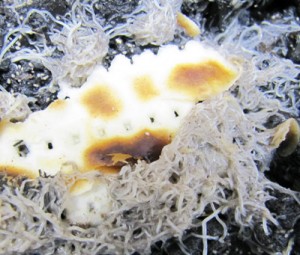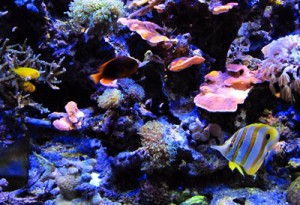Live worms are about the best thing we can feed to our fish. How do I know this? Am I just making it up so I have something to write? Actually, no. Live California blackworms have been used for ornamental fish food since a few years after World War II, as that is when I started feeding them to my freshwater fish. Blackworms will get freshwater fish into spawning condition in no time, and I can attest that the same applies to saltwater fish.
Back in 1971, when I started in the saltwater aquarium hobby (I think it was on a Tuesday), I bought some of the first blue devils imported into the US. I probably first tried to feed them dried ants (when I started keeping aquariums back in the 50s, dried ants were about all that was sold for fish food) and then later switched over to some other dry food. The fish lived, but they always had ich, so I kept copper in the water.
A good deal for the devils
Then I decided to give my saltwater fish a treat. I offered them some of the blackworms I was feeding my freshwater fish. The fish loved them, and in a few weeks, something happened to one of the blue devils. Its normally clear fins turned blue like the rest of the fish and it just looked healthier. He (this specimen proved to be a male as you might have guessed) started to chase the six females. Their fins stayed clear, but they started to fill with eggs and wear makeup.
He started to spawn with the females, and for the seven years those fish lived, they always spawned—and that was in the early 70s when Paris Hilton couldn’t even keep a dog, much less saltwater fish!
Kicking copper to the curb
Something else also happened: I didn’t need to keep copper in the water any longer, as the fish would not seem to get ich. If I put new fish in the tank, they would get ich, but if I and the fish were lucky, the ich would disappear and the fish would live its normal life. My first clownfish lived for 12 years, and so did my figure-eight puffer. That does not seem like a long time today, but in the 70s, it would have been like Lindsay Lohan staying out of rehab for like six months.
Feeding the fish
The only drawback to feeding blackworms to saltwater fish is that the worms die in seconds in salt water. No matter, though. I feed them using a baster thing, and the worms don’t have a chance to hit the substrate, as they are instantly pounced on and eaten by everything in my tank except pipefish. Even corals (those that can) and anemones will eat them. I am not sure what the exact mechanism is that makes live worms so healthful, but from my 60+ years of fishkeeping experience, I can swear to it.
Buying the blackworms
I buy my blackworms from an LFS in small portions, but I understand much of the world does not have access to them and they have to be ordered online. The drawback here is that only large amounts can be obtained in this manner. The live worms can be stored in a refrigerator for a few weeks as long as they are rinsed every day. However, my wife works out every day and could probably take me in a fair fight, so I don’t keep them in the refrigerator. For my own safety, I prefer to keep them in a worm keeper that I designed.
The worm keeper

The worm keeper, which keeps the worms in shallow, moving fresh water, is just a trough or tray that was built from a PVC fence post sliced in half (much like my algae trough), but any tray could be used. The tray has a couple of purposes. First, I keep eggcrate in there and the worms seem to like to hang out in the holes. It also provides a place to put a small container of cheap carbon to help keep the water clean.
The water gets pumped from a small tank to the far end of the trough and through the container of carbon. It flows over the eggcrate and falls into a container in the tank. Most of the worms congregate there. A tiny powerhead is installed in a smaller container in the tank. This smaller container keeps the worms out of the powerhead because they don’t swim and won’t be able to get over the top of the open container into the powerhead.

The worms do reproduce in the keeper, but not fast enough to keep pace with demand unless you make a very large keeper.
Also, keep in mind that the worm keeper needs to be cycled just like a fish tank or the worms will rot in an hour. It will take a couple of weeks to complete the cycle.
Worm food
I feed the worms either paper towels or small amounts of instant mashed potatoes. They don’t really eat these items; they live on the products of decomposition from the towels or potatoes. I have studied them under a microscope, and they just seem to pump water through their bodies and use whatever is in the water—probably bacteria.
What about whiteworms?

I also feed live whiteworms, which need to be kept in soil. They look like blackworms but, as their name implies, are white. They multiply very fast, and a small culture can keep up with a tank of hungry fish, but they are hard to separate from the soil. The advantage of them is that they stay alive for a very long time in saltwater and if the fish miss them, they will live for the entire day and are a perfect food for mandarins who will hunt for them.
Do they have to be live?
For some reason, frozen and freeze-dried worms don’t offer fish the same benefits that live worms do. Also, “bloodworms” are not really worms at all and are, in my opinion, useless for saltwater fish.
Results don’t lie
Some of my fish are over 20 years old, and they generally die of old age or I give them away, as I almost never find a dead fish. (Once in a while, I do find ones that jump out because, unfortunately, healthy fish seem to think they can fly.) Plus, almost all of my fish, including my mandarins, are spawning. So every day, my fish get some live blackworms along with clam. (Clams are a good food because we are feeding the entire animal, but worms are still the best, so don’t just feed clams.)
I attribute the health and longevity of my fish to the live worms, but it could be my good looks or the three supermodels that help take care of my tank.
Then again, it’s probably the worms.
Photo credit: Paul Baldassano



